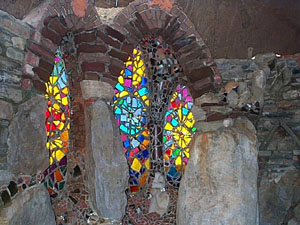Purple Doorknobs

A few weeks ago I found a box of old doorknobs in the basement. Among them was a pair of purple glass doorknobs. "Those wacky Victorians," I thought, "making different colors of doorknobs just to dress the house up." I learned, however, that the doorknobs weren't supposed to be purple - they started out colorless. (Thanks to Dad and my friend Nicole the Museum Conservator for enlightening me.)
Glass is made from silicon dioxide (sand) heated to high temperatures. Most glass contains traces of iron, which gives the glass a greenish tint. An additive called a decolorizer offsets the greenish hue. Before 1915, manganese dioxide was a common decolorizer. It acts as an oxidizer for the iron, converting the iron into an iron oxide that produces a yellowish, much less intense tint. (I learned this from the ever-helpful Corning Glass company.) An unexpected result, however, is that manganese will turn pinkish or purplish if exposed to ultraviolet radiation like sunlight. My doorknobs are an example of this "purpling." Most glass that purples naturally was produced between 1880 and WWI. In Beacon Hill (Boston) there are old brownstones, famous for their fine architecture and purple windows which have deepened in hue over time.
This effect became popular among antiques collectors in the 1970's, and many dealers artificially purpled their glass by exposing it to sunlight or UV radiation, ruining the value of many pieces. Collectors of glass insulators are also cautioned that many shades of glass available for sale have been unnaturally tinted by similar processes.
Info about how glass is produced in different colors here

